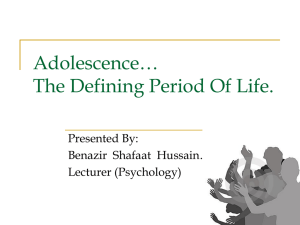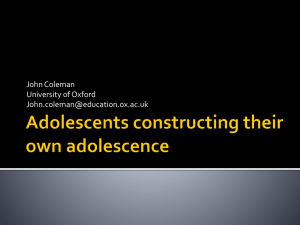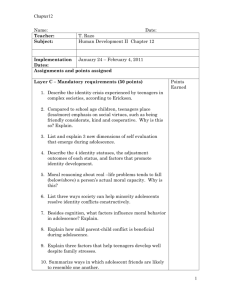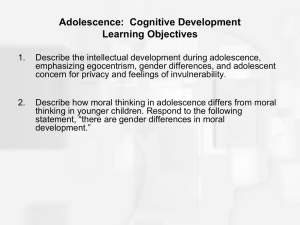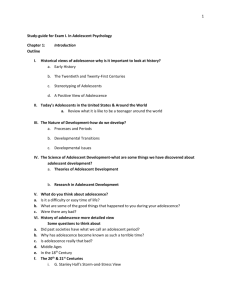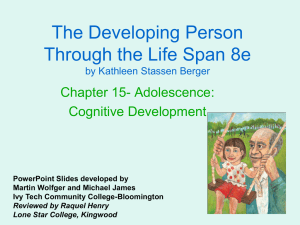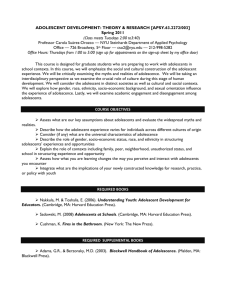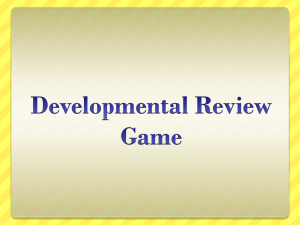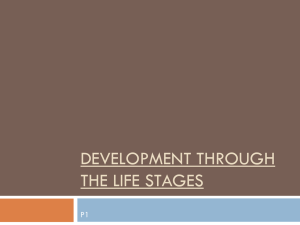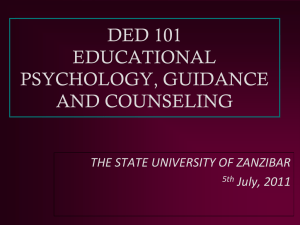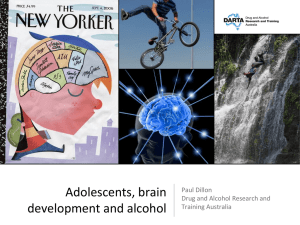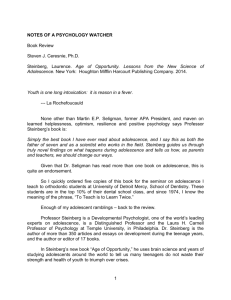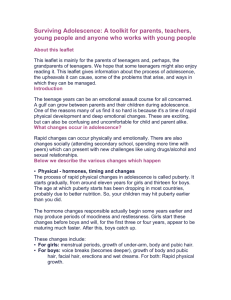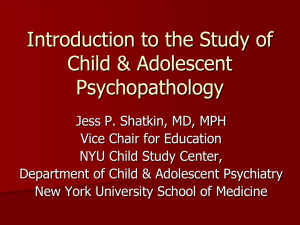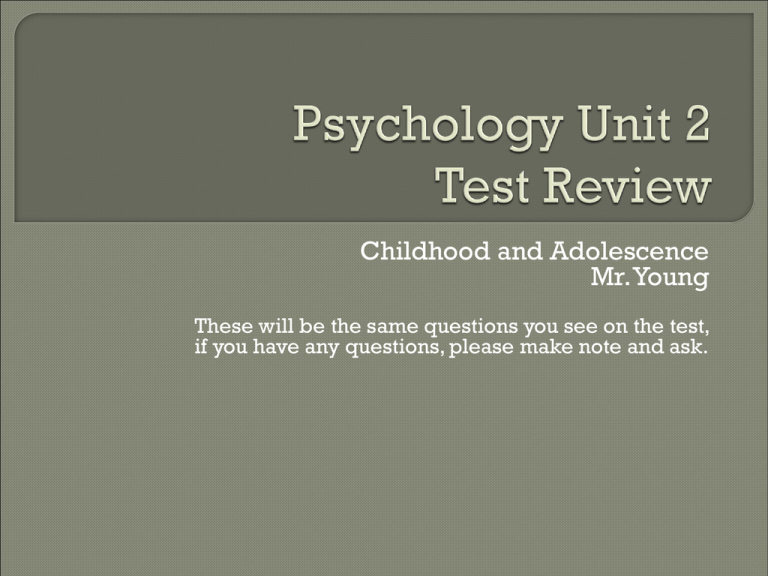
Childhood and Adolescence
Mr. Young
These will be the same questions you see on the test,
if you have any questions, please make note and ask.
Psychologists
call the internally
programmed growth of a child
a.
development. c.
b. assimilation. d.
maturation.
socialization.
Margaret
Mead believed that the
adolescence was different than that of G.
Stanley Hall because she studied groups
from this part of the world.
a. 3rd world countries
b. 1st world countries
c. 2nd world countries
d. outer space
An
infant who has developed object
permanence
a. is attached to specific objects.
b. will see all objects as the same.
c. knows that an object exists even if it
cannot be seen.
d. cries when objects are taken away.
A
newborn infant has certain automatic,
inherited, coordinated movement
patterns called
a. instincts. c.
schemas.
b. reflexes. d.
formal operations.
As
David Elkind explained, adolescents
will sometimes go throught this problem
in life, where they really have trouble
making decisions?
a. Asking parents for advice
b. Poor choice making
c. asking peers for adivce
d. Indecisiveness
Lawrence
Kohlberg identified six stages
of moral development. In Stage 1 a child
a.
is sensitive to what others want.
b. is concerned with law and order.
c. is totally egocentric.
d. thinks about rewards and
punishments.
What
or whom is the most important
factor in an adolescent’s moral
development?
a. peers
b. lifestyle
c. parents
d. gender
Jean
Piaget believed that children were
____________________, or when a young
child was unable to understand another
person’s perspective or point of view
a. representationl thought
b. egocentric
c. selfish
d. being themselves
When
a infant responds by turning it
heads to the place being touched, it is
known as
a. grasping reflex
c.rooting reflex
b.
sucking reflex d.strong visual activity
According
to Jean Piaget, which term
refers to a child's attempt to understand
something new by fitting it into an
existing schema?
a. accommodation
b. assimilation
c. intuitive reasoning
d. sensorimotor intelligence
According
to Piaget, when we adjust or
change our schema to include newly
observed events or fit the characterisitcs
of a new object, we
a. Assimilation
b. intuitive reasoning
c. sensorimotor intelligence
d. Accomodation
Joan
uses the Golden Rule as her guide in
making moral judgments. She is
considered to be in ____ of Lawrence
Kohlberg's framework.
a. Stage 6
c. Stage 4
b. Stage 5
d. Stage 3
Most
children will play games so they
can be involved in __________________,
when children’s play involves assuming
adult roles, thus enabling the child to
experience different points of view.
a. Egocentric
b. role taking
c. rationalization
d. schema
A person's gender role is defined by
a. partially one's genetic makeup.
b. cultural influences.
c. traditionally masculine or feminine
behavior.
d. all of the above.
The
concept of adolescent identity
categories, broken into 4 stages, is
associated with
a. Jean Piaget.
b. Lawrence Kohlberg.
c. James Marcia.
d. Sandra Bem.
Simone, a
typical adolescent, will most
likely turn to her peers for advice on
a. marriage.
c. fashion.
b. religion.
d.educational plans.
The
big question that an adolescent must
answer before they can form an identity
is
a.
“Who Am I?”
b. “What is my purpose?”
c. “Why am I here?”
d. “Where is Chuck Norris?”
An
a.
androgynous role is one that
reflects traditionally feminine
characteristics.
b. combines traditional male and female
characteristics.
c. reflects traditionally male characteristics.
d. combines various gender stereotypes.
A
person's behavior usually develops as
a result of
a.
attitudes only.
b. heredity only.
c. environment only.
d. both heredity and environment.
At
a.
birth, the length of most infants is
12 to 16 inches.
b. 20 to 24 inches.
c. 18 to 22 inches.
d. less than 12 inches.
Before
pushing an infant to master new
skills, parents should wait until the infant
reaches
a. maturational readiness.
b. physical readiness.
c. perceptual readiness.
d. motor readiness.
The
rules for arranging language
symbols to produce new meaning are
called
a.
syntax.
b. grammar.
c.telegraphic speech
d.none of the above.
Which
of the following is NOT a primary
issue for developmental psychologists?
a.
stability versus change
b. nature versus nurture
c. consistency versus inconsistency
d. continuity versus stages of
development
Groups
will usually stay in power by
ordering all group members to
participate in this, sometimes known as
the “glue” that keeps them together?
a. Conformity
b. resources
c. loyalty
d. money
How
do psychologists explore how
infants perceive the world?
a. by giving them brain scans that show the
activity in the brain during stimulation
b. by measuring behaviors that they can observe
such as sucking, eye movements, crying, and
smiling
c.
by teaching them new tricks
d. by making educated, but unsubstantiated,
guesses
What
two abilities involve using
symbols?
a.
language and depth perception
b. reading and walking
c. walking and talking
d. language and thought
By
the age of two, children have a
vocabulary of about
a.
500 to 1000 words.
b. 2500 to 5000 words.
c. about 10000 words.
d. several thousand words.
Mary
Ainsworth discovered which of the
following patterns of attachment in
children?
a. secure attachment
b. avoidance attachment
c. resistant attachment
d. all of the above
When
children engage in ____, they are
able to picture things in their minds.
a.
representational thought
b. conservation
c. egocentric thought
d. attachment
During
the ____ stage of cognitive
development (described by Jean Piaget),
children develop the ability to use logical
schemas.
a. sensorimotor
b. preoperational
c. concrete operations
d. formal operations
In
Harry Harlow's surrogate mother
experiment, young monkeys chose the
cloth mother out of their need for
a.
food.
b. object permanence.
c. imprinting.
d. physical contact comfort.
Which
of the following parenting styles
allows children and adolescents to
participate in decisions that affect their
lives?
a. authoritarian family
b. democratic/authoritative family
c. permissive family
d. laissez-faire family
According
to this psychologist, building
an identity is unique to the adolescent
stage?
a.
Sigmund Frued
b. Margaret Mead
c.
d.
Erik Erickson
Hans Wagner
During
the ____ stage of psychosexual
development (described by Sigmund
Freud), children push sexual desires into
the background and become involved in
exploring the world and learning new
skills.
a. oral
c.genital
b. anal
d.latency
Margaret
Mead theorized that
adolescence marked by storm and stress
was a by-product of
a. a less-developed country.
b. an industrialized society.
c. declining morality.
d. a transitional society.
The
first major theory of adolescence,
presented by G. Stanley Hall, presented
adolescence as a(n)
a. enjoyable time in life.
b. learning stage in which children
learned to be adults.
c. transitional stage characterized by
storm and stress.
d. continuous development pattern from
childhood to young adulthood.
According
to Piaget, during adolescence,
the ____ cognitive stage is typically
reached.
a. sensorimotor
b. preoperational
c. concrete operations
d. formal operations
If
adolescents develop a "messiah
complex," they think they can
a. convert others to their religion.
b. save the world from evil and are
invincible
c. excel in every way.
d. none of the above.
Out
of the 6 stages presented by David
Elkind, adolescents will usually find fault
with these types of figures, which they
once idolized but now realize do not live
up to their standards?
a. Authority figures
c.Teachers
b. Peers
d.Parents
The
identity category, proposed by
Jamses Marcia, in which adolescents have
considered many possible identities and
freely committed themselves to
occupations and other important life
matters is
a. identity moratorium.
b. identity foreclosure.
c. identity diffusion.
d. identity achievement.
Which
of the following researchers
believed that crisis is involved in
adolescent identity development?
a.
A.C. Peterson and James Marcia
b. Erik Erikson and James Marcia
c. A.C. Peterson and Margaret Mead
d. Erik Erikson and Albert Bandura
Peer
groups tend to set the standards on
such matters as
a. marriage and religion.
b. most basic values.
c. educational plans.
d. fashion and music preferences.
One
of the principal developmental tasks
for adolescents is
a.
b.
c.
d.
becoming independent of their families.
learning to depend on others for help.
getting a job so they can move out on their ow
breaking away from their peers.
Which
of the following behaviors do
depressed teenagers exhibit?
a. rebelliousness
b. withdrawal
c.drug and alcohol use
d. all of the above
1
in every 100 teenage girls will suffer
from this, a serious eating disorder
characterized by a fear of gaining weight
that results in prolonged self-starvation
and dramatic weight loss
a. anorexia
c.drug abuse
b. depression
d.bulimia
Which
of the following is NOT a function
of a clique?
a. It fulfills the need for closeness with others.
b. It gives the adolescent a way of establishing an
identity.
c.
It helps the adolescent achieve self-confidence
and a sense of independence from family.
d. It defines an adolescent's basic values about
marriage, religion, and future educational plans.
The
____ theory states that children
acquire gender roles by interacting with
their environment and thinking about
those experiences.
a. social learning
b. biological
c.cognitive-developmental
d. psychoanalytical
Your
awareness of being male or female
or your physical or biological makeup is
your
a. gender role.
b. gender identity.
c. gender stereotype.
d. gender schema.
The
transition period between childhood
and adolescence is known as
a.
Teenager
b. Adolescence
c.Children
d. Hoodlums
As
an adolscent, Parents/Guardians will
have the most affect on your decisions
based on
a.
Religion
b. Marriage
c.Educational future
d.All the above



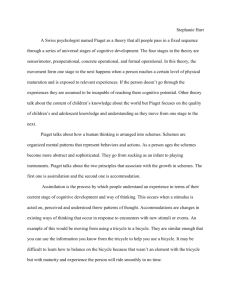

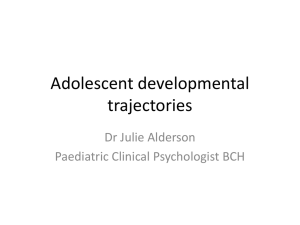
![Adolescence in 20th Century Literature and Culture [DOCX 16.08KB]](http://s3.studylib.net/store/data/006806148_1-4fb552dd69cbfa44b08b2f880802b1fe-300x300.png)
